Snaefellsnes is a large peninsula extending from West Iceland, often nicknamed "Iceland in Miniature" due to the wealth and diversity of natural features found there.
The Snaefellsnes peninsula is a scenic region in West Iceland, boasting a diverse landscape of glaciers, mountains, lava fields, and coastal beauty. It's home to the Snaefellsjokull National Park, at the center of which sits the Sneafellsjokull subglacial volcano that towers over the scenery.
Why You Can Trust Our Content
Guide to Iceland is the most trusted travel platform in Iceland, helping millions of visitors each year. All our content is written and reviewed by local experts who are deeply familiar with Iceland. You can count on us for accurate, up-to-date, and trustworthy travel advice.
In clear weather, the Snaefellsnes peninsula can be seen from Reykjavik, making views across the Faxafloi Bay from the capital particularly beautiful. The region is just a two-hour drive from Reykjavik, and you can easily see its main attractions on a day trip with a rental car.
You can find many tours of the Snaefellsnes peninsula. Choose the convenience of a guided tour or enjoy the freedom of a self-drive tour. It's also a great way to extend a tour of the Ring Road. For example, this 10-day self-drive tour of the complete Ring Road brings you around Iceland and includes the main attractions of the Snaefellsnes peninsula.
 As you choose your accommodation in Iceland, it's recommended to plan a night on the Snaefellsens peninsula. It will take two or more days to see all that the region has to offer, with amazing sights and memorable experiences around every corner. Check out the top things to do on the Snaefellsnes peninsula when planning your itinerary!
As you choose your accommodation in Iceland, it's recommended to plan a night on the Snaefellsens peninsula. It will take two or more days to see all that the region has to offer, with amazing sights and memorable experiences around every corner. Check out the top things to do on the Snaefellsnes peninsula when planning your itinerary!
Geography
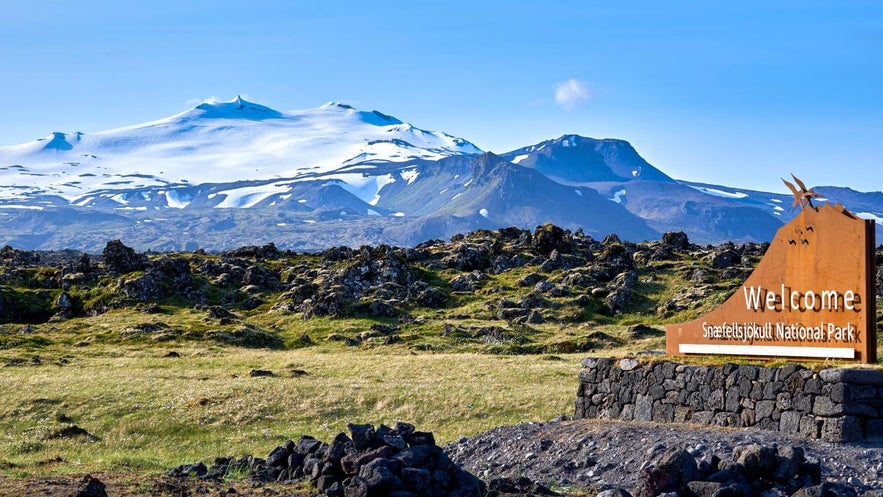 The Snaefellsnes peninsula stretches 56 miles (90 kilometers) from West Iceland, between the Reykjanes peninsula to the south and Westfjords to the north. Along the peninsula runs a mountain range that consists of both active and dormant volcanoes, culminating at the magnificent, Snaefellsjokull glacier. It sits atop a stratovolcano, which last erupted around 1,900 years ago, shaping much of the surrounding terrains.
The Snaefellsnes peninsula stretches 56 miles (90 kilometers) from West Iceland, between the Reykjanes peninsula to the south and Westfjords to the north. Along the peninsula runs a mountain range that consists of both active and dormant volcanoes, culminating at the magnificent, Snaefellsjokull glacier. It sits atop a stratovolcano, which last erupted around 1,900 years ago, shaping much of the surrounding terrains.
The geographical history of the Snaefellsnes peninsula is rooted in volcanic activity and the ongoing processes of nature. Lava flows from numerous eruptions have created a varied landscape, including vast lava fields covered in moss and vegetation, showcasing the peninsula's regenerative natural processes.
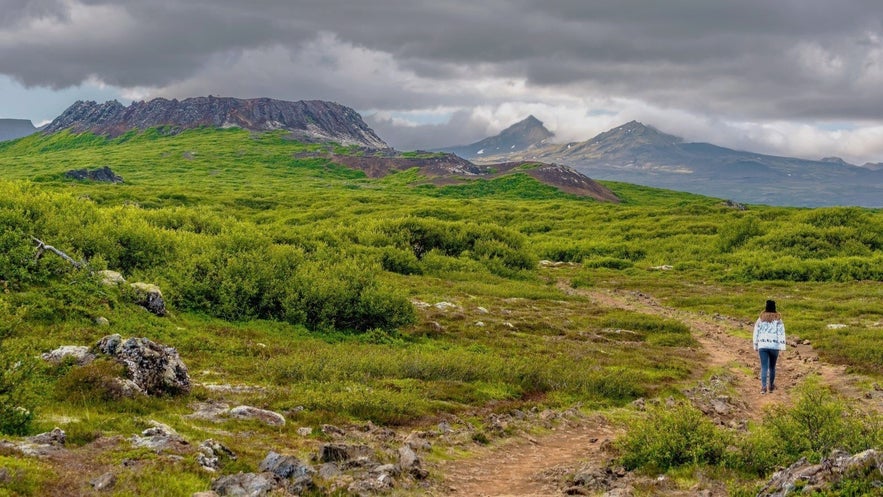
The coastline of the Snæfellsnes Peninsula is a striking blend of white and black sand beaches, while towering cliffs and dramatic rock formations serve as nesting grounds for a diverse array of seabirds. This rugged landscape, shaped by volcanic activity and sculpted by millennia of erosion and weathering, gives the region its distinctive character.
The peninsula’s vegetation is equally varied, with vast expanses of moss, lichen, and hardy shrubs dominating the terrain. Amidst this wild beauty, pockets of low-growing birch and willow trees add a touch of greenery to the otherwise windswept environment.
Human settlements on the Snæfellsnes Peninsula are scattered across charming fishing villages, small towns, and remote hamlets, where both fishing and tourism play vital roles in the local economy. Beyond the settlements, lush grassy fields host numerous farms, adding to the peninsula’s picturesque and pastoral charm.
Main Attractions on the Snaefellsnes Peninsula
Starting along the south side of the Snaefellsnes peninsula, you will first come to the Eldborg crater, which can be scaled for some incredible views, and the Gerduberg basalt cliffs, where hundreds of hexagonal basalt columns stretch over a length of over half a mile (1 kilometer). You will then start hugging the coast, where animal lovers can stop by the Ytri-Tunga beach to observe its year-round seal colony.
The next site of particular natural beauty is the Raudfeldsgja Gorge, a cleft in a huge cliff face that you can climb into. A stream runs through here, so make sure to wear waterproof clothing and sturdy shoes to attempt the climb and have a change of clothes ready for your return.
After Raudfeldsgja, you will come to the mighty basalt plugs of Londrangar. All that remains of what was once a massive crater, these two enormous pillars are not only awe-inspiring in their scale but home to thousands of nesting seabirds.
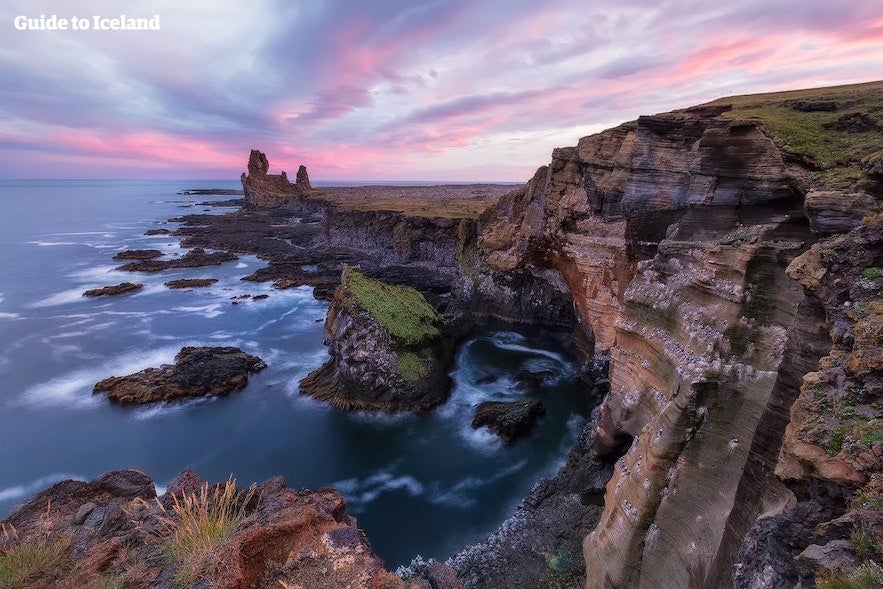
You will then enter Snaefellsjokull National Park, the smallest of Iceland’s three national parks. It's filled with gorgeous landscapes, stunning destinations, and things to do.
One of these locations is the Djupalonssandur beach. Comprised of black volcanic sands, and beautiful rock formations, it is best known for the four lifting stones that remain on the beach from a bygone age. Fishermen would use these stones to mark their strength and gauge their suitability to work on the dangerous waves.
Within the Snaefellsjokull National Park are also two lava caves that are worth a visit. Songhellir is renowned for the musical qualities of its echoes, but it's only accessible in summer. The Vatnshellir cave, however, is open all year and is favored for its easy access and vivid coloration. The only way to visit is with this guided 50-minute Vatnshellir cave tour.
The highlight of this part of the peninsula is no doubt the Snaefellsjokull glacier itself. Even if you are not ascending it on a glacier tour, it is worth stopping by to marvel at. There are also many hiking paths at the root of the glacier, but you should never go on the ice cap itself without a guide.
 This is a must-visit location for literature enthusiasts. When you do a glacier hiking tour on Snaefellsjokull, you'll reach the starting location of Jules Verne's novel "A Journey to the Centre of the Earth." The glacier is also the backdrop to the novel "Under the Glacier," by Nobel-Prize-winning Icelander Halldór Laxness.
This is a must-visit location for literature enthusiasts. When you do a glacier hiking tour on Snaefellsjokull, you'll reach the starting location of Jules Verne's novel "A Journey to the Centre of the Earth." The glacier is also the backdrop to the novel "Under the Glacier," by Nobel-Prize-winning Icelander Halldór Laxness.
On the north side of the Snaefellsnes peninsula is the haunting Berserkjahraun lava field near the town of Bjarnarhofn. Most notable on this stretch, however, is Kirkjufell, often described as the most photographed mountain in Iceland. It famously features as "the mountain shaped like an arrowhead" in the popular HBO series, Game of Thrones.
Towns on the Snaefellsnes Peninsula
 There are small and beautiful villages dotted across the Snaefellsnes peninsula, the majority of which are on the northern side, where fishing is better. Most notable are Arnarstapi, Hellnar, Budir, Hellissandur, Olafsvik, Grundarfjordur, and Stykkisholmur.
There are small and beautiful villages dotted across the Snaefellsnes peninsula, the majority of which are on the northern side, where fishing is better. Most notable are Arnarstapi, Hellnar, Budir, Hellissandur, Olafsvik, Grundarfjordur, and Stykkisholmur.
Stykkisholmur is the largest town on the Snaefellsnes peninsula and is highly popular among travelers. The town is known for its traditional Icelandic houses and a beautiful harbor framed by the Sugandisey island.
From the harbor, you can take the Baldur ferry to the Westfjords, and on the way, you'll see the beautiful Breidafjordur Bay. You can also stop at the remote Flatey island. From the Snaefellsnes coast, you can also try this whale-watching tour from Olafsvik. During summer, the region is also rich in birdlife, which you can observe during this puffin-watching tour!
Other cultural attractions in the region include the Norweigan House in Stykkisholmur, the Pakkhusid Museum in Olafsvik, and, last but not least, the Bjanarhofn Shark Museum, where you can taste a staple of traditional Icelandic food, the "hakarl" or fermented shark.
The Best Time to Visit the Snaefellsnes Peninsula
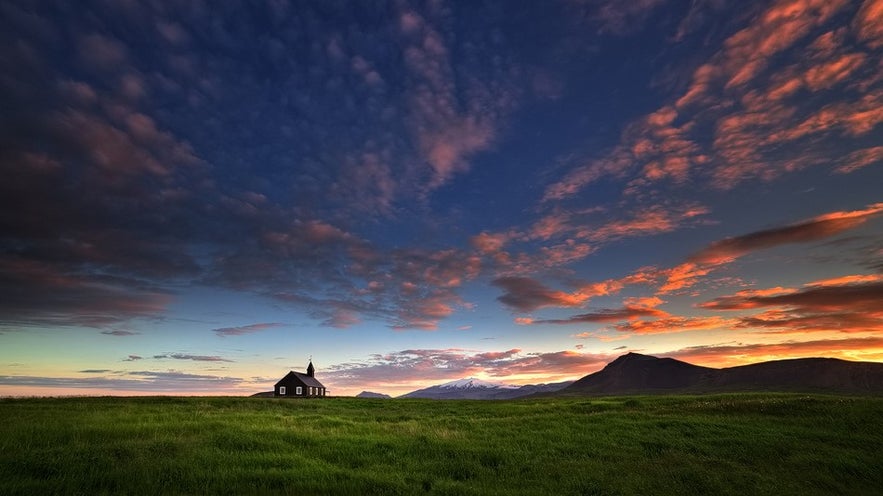 The best time to visit the Snaefellsnes peninsula largely depends on what experiences you're seeking. In general, it's best to visit Iceland in summer, specifically from June to August, as the weather is mild and temperatures range from 10-18°C. The comfortable conditions also mean that you'll be able to reach most attractions with a small rental car during your summer self-drive tour.
The best time to visit the Snaefellsnes peninsula largely depends on what experiences you're seeking. In general, it's best to visit Iceland in summer, specifically from June to August, as the weather is mild and temperatures range from 10-18°C. The comfortable conditions also mean that you'll be able to reach most attractions with a small rental car during your summer self-drive tour.
Summer also has the benefit of the midnight sun, a natural spectacle where the sun barely sets, offering extended daylight hours for exploration.
While the dramatic landscapes of the Snaefellsnes peninsula are beautiful when draped in the icy winter snow, the main benefit of visiting during the colder months is the chance to spot the northern lights.
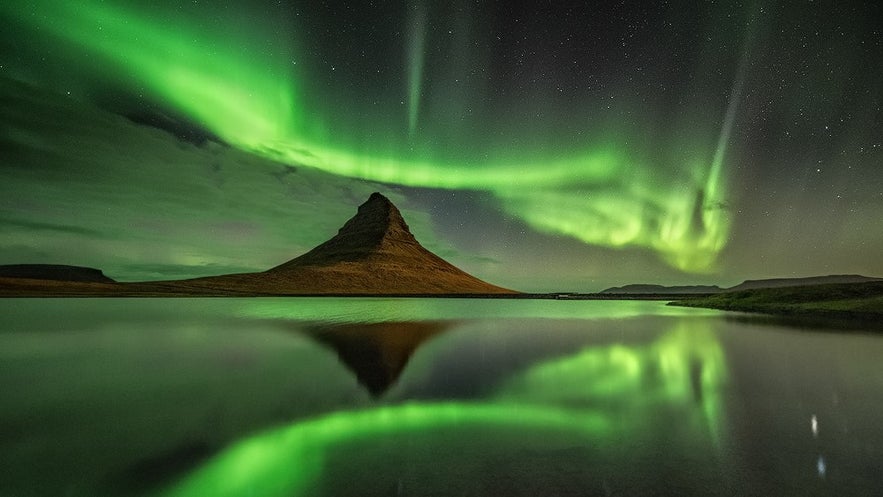 If you want to see the northern lights in Iceland, it's best to visit between late September and early April. During these months, the nights are much darker, providing the perfect canvas for the aurora borealis' mesmerizing displays of light.
If you want to see the northern lights in Iceland, it's best to visit between late September and early April. During these months, the nights are much darker, providing the perfect canvas for the aurora borealis' mesmerizing displays of light.
Though winter visits come with the challenges of colder weather and limited daylight, they also offer the serenity and beauty of the peninsula adorned in snow. It's best to rent a 4x4 vehicle when doing a winter self-drive tour in Iceland, but if you're not confident in driving in snow and difficult icy conditions, it's better to choose a guided tour for safe winter exploration.
Where to Stay on the Snaefellsnes Peninsula
The choice of the best place to stay on the Snaefellsnes peninsula can vary depending on your needs and interests, but there are plenty of Snaefellsnes accommodations to choose from.
The most popular place to stay is in Stykkisholmur. As the largest town in the region, it offers access to all necessary services, and you'll be able to enjoy local restaurants, stores, and cultural attractions. There are great accommodation options in Stykkisholmur that suit different needs, preferences, and budgets, one of the best options being the historic Hotel Egilsen.
If you want to stay close to natural wonders, you may want to choose accommodation in Hellissandur. The village is known for its proximity to the Snaefellsjokull National Park and the abundance of outdoor activities available in the vicinity. For your stay, we recommend either The Freezer Apartments or Freezer Hostel.
You can also stay in the town of Grundafjordur for views of the Kirkjufell mountain or find convenient accommodation in Olafsvik to stay closer to the tip of the peninsula.
FAQs About the Snaefellsnes Peninsula

How do I go to the Snaefellsnes Peninsula?
The Snaefellsnes peninsula is accessible by a small rental car in summer or a 4x4 rental car in winter, so you can visit as part of a self-drive tour. There are also many guided tours available to the region, like this small group tour with a transfer from Reykjavik.
It is possible to take a public bus from Reykjavik to Stykkisholmur, but there is no public transport within the region. Unfortunately, it's not possible to bring a bike with you on the public bus, so you'll have a hard time moving between locations without access to a rental car or tour bus.
How much time should I spend on the Snaefellsnes peninsula?
You can explore the major sights of the Snaefellsnes region in a day. The drive from Reykjavik to the Snaefellsnes peninsula takes around two hours, and then it will take a further four to five hours to drive around the whole coastline.
You should account for around eight to ten hours for a day trip, depending on how much you want to explore. To see all that the region has to offer, you'll have to spread your trip over two or more days and stay in accommodation on the Snaefellsnes peninsula. Alternatively, you can rent a campervan.

Can I see the northern lights from the Snaefellsnes peninsula?
Yes, if you're visiting the Snaefellsnes peninsula between late September and early April, you may be able to spot the northern lights! You can easily find areas on the Snaefellsnes peninsula with very low levels of light pollution, but visibility is subject to weather conditions, cloud cover, and solar activity. It's always a good idea to monitor the weather and aurora forecast before going hunting for the northern lights.
Keep in mind that the aurora borealis is visible from most places in Iceland, including on the edge of the Capital Region. You can also find many northern lights tours around Iceland that will bring you to convenient locations for spotting them.

What wildlife can I see on the Snaefellsnes peninsula?
On the Snaefellsnes peninsula, you'll have the opportunity to encounter a diverse array of wildlife. In the vast lava fields and mountains, you may spot minks and even the elusive Arctic fox if you're lucky.
Marine life is abundant along the coastline. Seals are often spotted lounging on the shores, especially near Ytri Tunga beach, a well-known seal colony. The rich waters surrounding the peninsula are also home to various whale species, including orcas, minke whales, and humpbacks, making it a great spot for whale-watching.
Bird enthusiasts are in for a treat, as the cliffs and coastal areas serve as nesting grounds for numerous bird species. The iconic puffin, with its colorful beak and expressive eyes, can often be seen in summer. In addition, guillemots, razorbills, kittiwakes, and fulmars are other common inhabitants.
What can I see on the way to the Snaefellsnes peninsula?
To reach the Snaefellsnes peninsula from Reykjavik, you'll have to drive for two hours through West Iceland. You can easily expand your journey and take the day to explore the region!
On the way, you can drive through the Hvalfjordur Fjord by skipping the Hvalfjardargong tunnel. It adds an hour of driving to your trip, but you'll see beautiful scenery on the way. You can also stop to relax at the Hvammsvik Hot Springs or expand the trip further with an afternoon hike up the Glymur Waterfall.
Further on, you can drive the Borgarfjordur Fjord, which is worth a day trip of its own. You can visit the beautiful Hraunfossar and Barnafoss Waterfalls and the Deildartunguhver Hot Spring. While there, enjoy a soak at the Krauma Spa and then visit the Haafell goat farm. You can even visit man-made ice tunnels in the Langjokull glacier!
After your tour of the Snaefellsnes peninsula, you can even expand your trip further by visiting the Westfjords. With so much to offer, it's easy to spend multiple days exploring the beauty of West Iceland.









